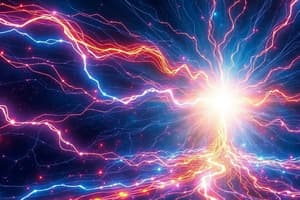Podcast
Questions and Answers
What is the unit of measurement for electric fields?
What is the unit of measurement for electric fields?
- Volts per meter (V/m) (correct)
- Ohms (Ω)
- Teslas (T)
- Amperes (A)
Which statement accurately describes Coulomb's Law?
Which statement accurately describes Coulomb's Law?
- It describes the relationship between electric fields and magnetic fields.
- It quantifies the force between two point charges based on their distances. (correct)
- It demonstrates how electric currents create magnetic fields.
- It states that opposite charges repel each other.
What is the significance of Faraday's Law of Induction?
What is the significance of Faraday's Law of Induction?
- It states that an electric field is created by a changing magnetic field. (correct)
- It describes the force between electric charges.
- It calculates the total charge in a given volume.
- It relates the magnetic field to the electric current in a circuit.
What do Maxwell's Equations collectively describe?
What do Maxwell's Equations collectively describe?
Which law relates the magnetic field to the electric current that produces it?
Which law relates the magnetic field to the electric current that produces it?
Which of these options correctly lists types of electromagnetic waves?
Which of these options correctly lists types of electromagnetic waves?
What is a common application of electromagnetic induction?
What is a common application of electromagnetic induction?
Electromagnetic waves propagate at approximately what speed?
Electromagnetic waves propagate at approximately what speed?
Which concept explains why like charges repel and opposite charges attract?
Which concept explains why like charges repel and opposite charges attract?
What does a magnetic field result from?
What does a magnetic field result from?
Flashcards are hidden until you start studying
Study Notes
Electromagnetism
-
Definition: Branch of physics studying electric charges, magnetic fields, and their interactions.
-
Key Concepts:
- Electric Charge: Fundamental property of matter; exists in positive and negative forms.
- Like charges repel; opposite charges attract.
- Electric Field (E): Region around charged objects where forces can be exerted on other charges.
- Measured in volts per meter (V/m).
- Magnetic Field (B): Region around magnets or moving electric charges that exerts magnetic forces.
- Measured in teslas (T).
- Electric Charge: Fundamental property of matter; exists in positive and negative forms.
-
Fundamental Laws:
- Coulomb's Law: Describes the force between two point charges.
- F = k * (|q1 * q2| / r²), where k is Coulomb's constant.
- Gauss's Law: Relates electric fields to the charge enclosed in a closed surface.
- ∮E•dA = Q_enc/ε₀.
- Faraday's Law of Induction: A changing magnetic field creates an electric field.
- ε = -dΦ_B/dt, where Φ_B is the magnetic flux.
- Ampère's Law: Relates magnetic fields to the electric current that produces them.
- ∮B•dl = μ₀I_enc.
- Coulomb's Law: Describes the force between two point charges.
-
Electromagnetic Waves:
- Created by the oscillation of electric and magnetic fields.
- Propagate at the speed of light (c ≈ 3 x 10^8 m/s).
- Includes radio waves, microwaves, infrared, visible light, ultraviolet, X-rays, and gamma rays.
-
Maxwell's Equations: Four fundamental equations describing electromagnetism:
- Gauss's Law for Electricity
- Gauss's Law for Magnetism
- Faraday's Law of Induction
- Ampère-Maxwell Law
-
Applications:
- Electric circuits (Ohm's Law, Kirchhoff’s rules)
- Electromagnetic devices (motors, generators, transformers)
- Communication technologies (radio, television, mobile phones)
- Medical imaging (MRI)
-
Key Phenomena:
- Electromagnetic induction: Process of generating current with a changing magnetic field.
- Electromagnetic radiation: Energy emitted in the form of waves (e.g., light).
-
Important Constants:
- Speed of light (c): 3 x 10^8 m/s
- Permittivity of free space (ε₀): 8.85 x 10^-12 F/m
- Permeability of free space (μ₀): 4π x 10^-7 T·m/A
-
Units:
- Charge: Coulombs (C)
- Electric Field: Volts per meter (V/m)
- Magnetic Field: Teslas (T)
- Current: Amperes (A)
Electromagnetism Overview
- Study of electric charges, magnetic fields, and their interactions.
Key Concepts
- Electric Charge: Exists in positive or negative forms; like charges repel, opposite charges attract.
- Electric Field (E): Surrounds charged objects, influencing other charges, measured in volts per meter (V/m).
- Magnetic Field (B): Surrounds magnets or moving electric charges, exerting magnetic forces, measured in teslas (T).
Fundamental Laws
- Coulomb's Law: Describes force between two charges, represented as F = k * (|q1 * q2| / r²); k is Coulomb's constant.
- Gauss's Law: Connects electric fields to enclosed charges, expressed as ∮E dA = Q_enc/ε₀.
- Faraday's Law of Induction: Establishes that a changing magnetic field generates an electric field, noted as ε = -dΦ_B/dt.
- Ampère's Law: Relates magnetic fields to electric currents, given as ∮B dl = μ₀I_enc.
Electromagnetic Waves
- Formed by oscillating electric and magnetic fields, they travel at the speed of light (c ≈ 3 x 10^8 m/s).
- Types include radio waves, microwaves, infrared, visible light, ultraviolet, X-rays, and gamma rays.
Maxwell's Equations
- Fundamental equations of electromagnetism include:
- Gauss's Law for Electricity
- Gauss's Law for Magnetism
- Faraday's Law of Induction
- Ampère-Maxwell Law
Applications
- Electric circuits: Implement Ohm's Law and Kirchhoff’s rules for circuit analysis.
- Electromagnetic devices: Applications in motors, generators, and transformers.
- Communication technologies: Utilized in devices such as radios, televisions, and mobile phones.
- Medical imaging: Techniques like MRI use electromagnetic principles.
Key Phenomena
- Electromagnetic Induction: Process of producing electric current through a changing magnetic field.
- Electromagnetic Radiation: Energy transmitted as waves, exemplified by visible light.
Important Constants
- Speed of Light (c): 3 x 10^8 m/s.
- Permittivity of Free Space (ε₀): 8.85 x 10^-12 F/m, a measure of how much electric field is permitted to pass through a vacuum.
- Permeability of Free Space (μ₀): 4π x 10^-7 T·m/A, relates to how a magnetic field influences and is influenced by a vacuum.
Units
- Charge: Measured in Coulombs (C).
- Electric Field: Expressed in volts per meter (V/m).
- Magnetic Field: Quantified in teslas (T).
- Current: Measured in amperes (A).
Studying That Suits You
Use AI to generate personalized quizzes and flashcards to suit your learning preferences.




